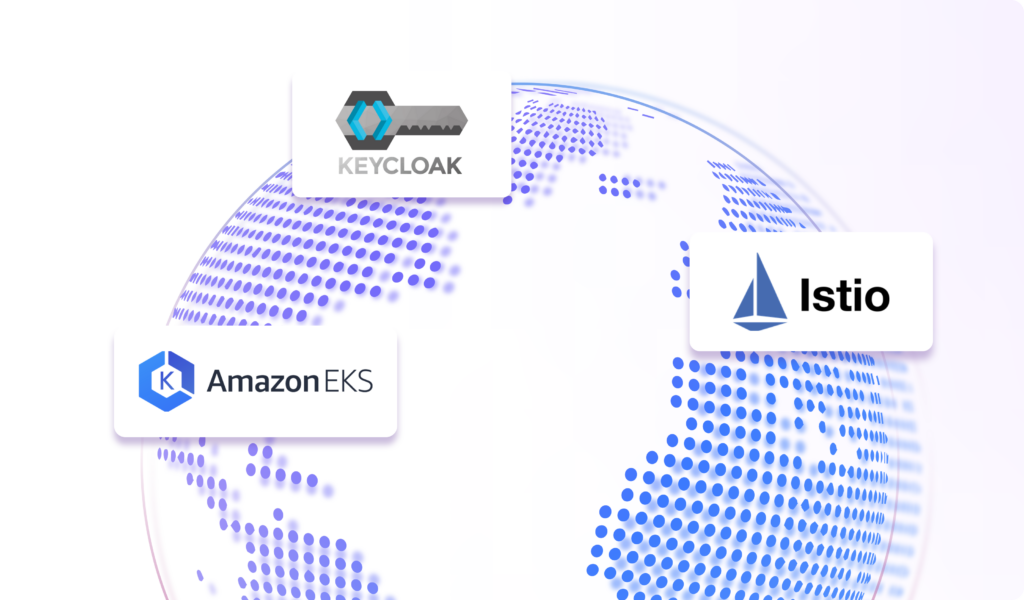Top 6 Solutions for Kubernetes Intrusion Protection with IDS and IPS
25.04.2023
3 minues

The distributed nature of a Kubernetes containerized environment can present significant challenges. In fact, according to a recent survey, 42% of developers consider security to be the primary issue in container orchestration platforms. Furthermore, 55% report that release delays occur due to security concerns. However, with effective solutions such as IDS and IPS for Kubernetes, you can enhance your environment’s visibility and mitigate more threats.
This article will explore intrusion prevention (IPS) and intrusion detection systems (IDS) for Kubernetes (K8s), explaining how they can help you identify suspicious activities, intercept attacks, and optimize performance. As an added bonus, we will review some of the most popular solutions available on the market.
Intrusion detection and prevention systems: what do they entail?
If you’re not well-versed in this area, let’s start by reviewing the definitions of intrusion detection and prevention systems for Kubernetes.
Systems for detecting intrusions.
An intrusion detection system is a type of software that monitors your Kubernetes environment and produces alerts when it detects anomalies. These anomalies may include unauthorized system calls, suspicious requests to the Kubernetes API, malicious traffic patterns, DDoS attack patterns, or other types of vulnerability exploits. The system acts as a sort of watchdog, keeping a constant eye on your Kubernetes environment and raising the alarm it detects any suspicious behavior.
The methods used bt IDS solutions to analyze activities in your K8s cluster include:
- Signature-based detection. The system identifies potential incidents through the use of signatures, which are patterns that match known malicious sequences. This approach is effective for detecting previously documented attacks, but it is less effective when it comes to detecting zero-day vulnerabilities (such as unknown malware). Examples of the types of incidents that can be identified using this method include traffic directed at unsecured domains, the presence of malicious byte sequences, and requests with unusually large packet sizes.
- Abnormality identification. The approach utilizes machine learning to create a reliable activity model and contrast it with the actions taking place within your network. It is capable of notifying you about login attempts originating from unfamiliar locations, the addition of unauthorized devices, systematic scans aimed at identifying opened ports, and any zero-day exploits. However, developing and training such a model poses a significant challenge as it necessitates meticulous setup and a considerable amount of accurate data.
- Examination of protocol states. The security of your network is monitored by the system, which adheres to protocol standards set by the vendors. For instance, it can alert you to anomalies such as inconsistencies in the session authenticator, dubious behavior from particular user groups, or K8s arguments with uncommon length or binary data. Nevertheless, relying solely on this approach may prove inadequate and could lead to inaccuracies, particularly if your vendor’s protocol documentation is incomplete.
Numerous IDS products employ a combination of detection methods, typically including signature-based, anomaly detection, and stateful techniques. By using a hybrid approach, these products can detect and identify a wider range of threats.
It’s important to note that IDS is a Kubernetes intrusion detection solution that operates in a passive manner. These systems are capable of sending alerts to security information and event management (SIEM) systems, as well as security teams, for additional analysis. However, unlike IPS products, they do not actively protect your endpoints or address vulnerabilities.
Cyber threat prevention system
Similar to IDS for Kubernetes, intrusion prevention systems monitor and identify potential threats. However, in addition to detection capabilities, they provide measures to safeguard your environment, such as:
- Terminate any anomalous activity and restrict traffic originating from a container or an application
- Isolate traffic coming from impacted network segments
- Validate the integrity of corrupted content and try to restore it
- Verify whether security controls are in line with regulatory requirements and identify any violations
- Adjust security configuration settings to enhance protection following intrusion attempts
IPS can be seen as a supplement to IDS since they both identify potentially malicious activity and network traffic within your K8s clusters, pods, and applications. However, in addition to detection, IPS is capable of halting an attack as soon as it is detected.
Let’s go to the next point.
Is it advisable to deploy IDS and IPS for Kubernetes?
You may be wondering whether it’s necessary to deploy network intrusion prevention and detection systems for Kubernetes when you already have a firewall or built-in tools from your provider. However, the answer is “yes” for the following reasons.
The core principle of DevSecOps suggests that any system can be compromised given the attacker’s expertise, time, and motivation. Therefore, you require multiple techniques to prevent as many attacks as possible and respond to breaches quickly to minimize their impact.
While firewalls provide a basic level of security against some traffic, advanced attacks can evade them. Additionally, they do not safeguard your systems within the cluster if an attack breaches the perimeter.
Despite the robust access control, authentication, and authorization mechanisms provided by popular cloud computing platforms such as Amazon Web Services, Google Cloud, and Microsoft Azure, Kubernetes distribution is not completely immune to failure.
In addition to this, monitoring a large number of containers, pods, and underlying code efficiently can be a daunting task, which becomes even more challenging when deploying K8s across multiple cloud services.
By implementing IPS and IDS for Kubernetes, you can monitor your containers in real time, which helps you detect more threats and attacks, allowing you to patch up vulnerabilities promptly. Additionally, an IPS can isolate malicious traffic and repair the damage automatically.
Let’s move on from the theory and take a closer look at the available solutions that you can deploy to secure your Kubernetes infrastructure.
6 best-recommended intrusions detection and prevention solutions for K8s.
Below you can see the best tools created in order to guard your collection and containerized applications against security breaches, zero-day attacks, and other unusual incidents.
1. Aqua
The Aqua CNDR platform offers a range of tools for detecting, preventing, and automating responses to intrusions and anomalies across your K8s infrastructure. It leverages behavioral detection and eBPF (Berkeley Packet Filter) to identify network attacks, evasion techniques, and unfamiliar malware.
This platform can prove extremely beneficial for DevSecOps teams. Aqua CNDR evaluates and scores your workloads, helping your experts pinpoint vulnerable deployments, and enabling you to prioritize mitigation efforts. Additionally, it allows you to visualize inbound and outbound connections for each deployment, facilitating the identification of probable entry points for attacks.
Furthermore, Aqua can identify containers that were not part of your pipeline or that were modified post-deployment. This capability enables you to block containers and unauthorized access attempts effectively.
However, the platform falls short in its role-based access control (RBAC) granularity, necessitating manual permission settings for each cloud integration. It also does not group alerts, making it difficult for enterprises with a huge amount of microservices.
2. Datadog
Datadog is a monitoring tool that keeps an eye on every node in your K8s infrastructure, even if they are distributed across several clouds. It detects attacks against infrastructure, monitors clusters for security misconfigurations, and automatically reports on CIS benchmarks. Along with intrusion detection, it tracks resource metrics such as CPU, memory, and traffic load and logs autoscaling events.
This software supports over 500 integrations with common monitoring and log management tools, allowing you to have real-time visibility into your infrastructure. You also get application performance monitoring (APM) and distributed tracing to gain transaction-level insight into your activities. All logs and reports are automatically tagged and grouped for your convenience. For example, logs from Redis containers are tagged with service:redis and source:redis.
However, Datadog has limited documentation on its integrations and configurations, making it difficult to understand how to use it effectively. Additionally, its billing panel does not show your charges until the end of the month, which can be challenging for budgeting purposes. Furthermore, there is no way to set caps or limits, making it impossible to predict how much you will be charged.
3. Falco
Falco is a security tool designed for Kubernetes that operates at runtime and is open-source. It can be run directly in your K8s environment or kept separate for additional security measures in case of an attack.
With this tool, you can continuously monitor both your cluster and cloud logs for suspicious behavior, configuration changes, or potential data breaches. Falco can identify abnormal activity or intrusions based on system calls, Kubernetes audit logs, arguments, and properties of the calling process.
Falco is a popular solution with a strong community of developers that provides customizable threat detection policies and APIs. You can also find various SDKs and documentation to help you create custom plugins.
While Falco serves as an intrusion detection system, it lacks preventive capabilities, which means that your security team must manually analyze the alerts. Deploying at scale can be challenging without extra automation tools, especially if you have a large number of microservices. Moreover, the alerting configuration options are limited for containers of the same type.
4. Prisma Cloud
Prisma Cloud, formerly known as Twistlock, is a comprehensive solution for real-time intrusion prevention in Kubernetes environments. It provides virtual firewalls that inspect network traffic and only allow safe content to pass through, creating secure network boundaries across clusters.
The workload identifier feature assigns each container a unique cryptographic identity, blocking network access for unverified or unauthorized workloads. Prisma Cloud also includes compliance checks to prevent application misconfigurations throughout the application lifecycle. With over 400 customizable checks for common regulations such as GDPR, PCI DSS, and HIPAA, as well as various pre-built compliance templates, you can generate detailed reports on traffic, application, and threat detection for compliance audits.
However, regular updates to the platform may require reconfigurations and additional maintenance. Also, Prisma Cloud could benefit from more detailed technical documentation and responsive support.
5. Tigera Calico
Tigera Calico is a comprehensive security solution that uses machine learning algorithms and a rule-based engine to detect and mitigate data breaches and advanced persistent threats in microservices. The platform monitors all traffic flowing through your microservices and alerts you when it detects unusual behavior, allowing you to take remediation measures before any harm is done.
The networking plugin is easily scalable and has a low overhead, making it suitable for large-scale deployments. It also includes Honeypods, which are fake pods in your K8s cluster that capture malicious traffic and trigger in-depth analysis for known signatures.
Tigera Calico offers advanced encryption for extra protection of sensitive data, and a DNS dashboard helps you confirm and eliminate connectivity issues in your cluster.
However, the installation process can be complex, as it requires deploying numerous namespaces with dozens of pods. Additionally, the architecture consists of multiple sub-projects, which may make troubleshooting a bit tricky.
6. Wazuh
Wazuh is a platform designed for preventing threats in containerized environments that is available for free as open-source software. Its approach is based on signatures and a ruleset, which enables it to detect compromise indicators and security violations. In addition, the platform allows for analyzing endpoint configurations to minimize the cluster’s attack surface.
This platform offers various incident response solutions to address active threats, such as a robust search engine and visualization tool to assist security teams in processing flagged incidents. Furthermore, it includes security controls to ensure compliance with industry regulations.
On the other hand, Wazuh’s interface is somewhat clunky, and its documentation is lacking. Additionally, while the software is free, tools like CIS-CAT scanning require external licenses. Finally, users must configure monitoring capabilities and alerts manually.
It is worth noting that any IDS or IPS product requires users to configure network policies, signatures, and baseline behavior for their clusters. Otherwise, there is a risk of overwhelming the team with false alerts, overlooking real threats, or impeding productivity by blocking trustworthy traffic.
Summary
Safeguarding containerized environments is critical, and intrusion detection and prevention systems (IDS/IPS) offer adaptable solutions. For Kubernetes, IDS tools analyze network traffic within defined parameters, log activity records, and alert you to potential security threats. For even stronger network security, IPS can automatically block malicious activities and remediate anomalies.
However, to ensure optimal performance and protection, these tools require careful setup of security policies and remediation rules. If you need assistance, consider engaging an experienced software development company.
At Dedicatted, we have extensive technical expertise in container orchestration platforms like Kubernetes and DevSecOps. Our team can help you select, set up, and manage IDS/IPS solutions that suit your needs. Contact us today to learn how we can enhance the security of your K8s cluster.













